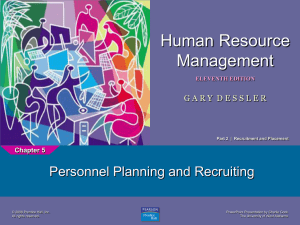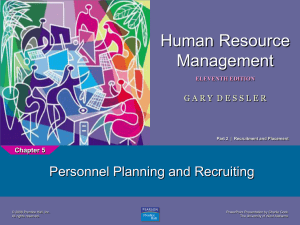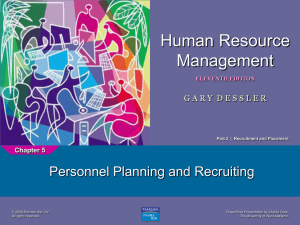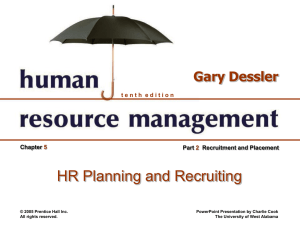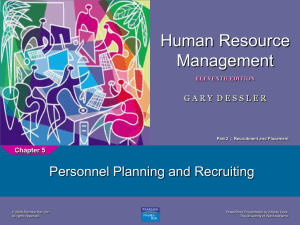No Slide Title - Departamento de Industria y Negocios
advertisement
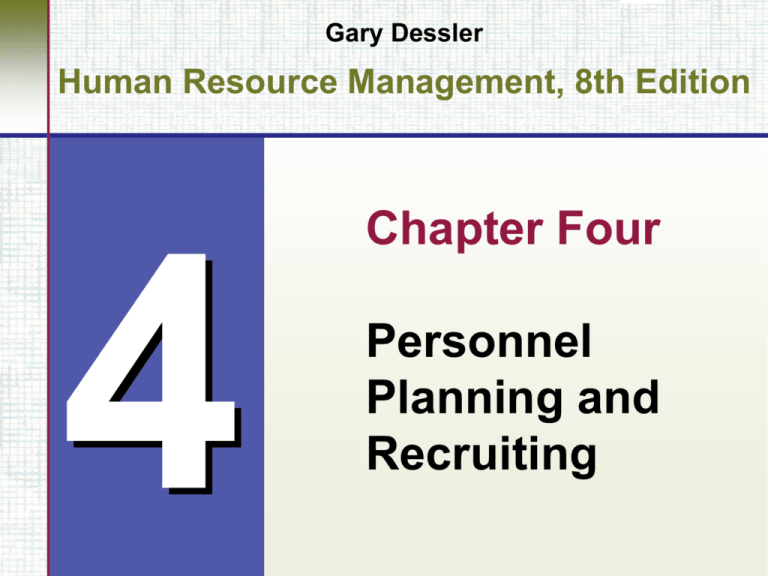
Gary Dessler Human Resource Management, 8th Edition Chapter Four Personnel Planning and Recruiting Behavioral Objectives When you finish studying this chapter, you should be able to: Explain the process of forecasting personal requirements. Discuss the pros and cons of eight methods used for recruiting job candidates. Describe how to develop an application form. Explain how to use application forms to predict job performance. © Prentice Hall, 2000 Chapter 4 1 Considerations in Forecasting Personnel Needs 1. Projected turnover (as a result of resignations or terminations) 2. Quality and skills of your employees (in relation to what you see as the changing needs of your organization) 3. Decisions to upgrade the quality of products or services or enter into new markets 4. Technological and other changes resulting in increased productivity 5. The financial resources available to your department © Prentice Hall, 2000 Chapter 4 2 How to Forecast Personnel Needs There are several ways to predict future employment needs. They include the following: Trend Analysis Ratio Analysis The Scatter Plot Using Computers to Forecast Personnel Requirements Managerial Judgment © Prentice Hall, 2000 Chapter 4 3 Number of Registered Nurses Determining the Relationship Between Hospital Size and Number of Nurses (1210) 1200 1000 800 600 400 200 200 400 600 800 1000 1200 1400 Hospital Size (No. of Beds) © Prentice Hall, 2000 Chapter 4 4 Recruiting Yield Pyramid 50 100 New hires Offers made (2:1) 150 Candidates interviewed (3:2) 200 Candidates invited (4:3) 1200 © Prentice Hall, 2000 Leads generated (6:1) Chapter 4 5 Recruiting Job Candidates Some sources of job candidates include: Advertising as a source of Candidates Employment agencies as a source of candidates Alternative Staffing Techniques Executive recruiters as a source of candidates College recruiting as a source of candidates Referrals and walk-ins as a source of candidates Recruiting on the Internet © Prentice Hall, 2000 Chapter 4 6 Types of Employment Agencies There are three types of employment agencies: Public agencies operated by federal, state, or local governments Agencies associated with nonprofit organizations Privately owned agencies © Prentice Hall, 2000 Chapter 4 7 Some Reasons for Choosing to Use and Employment Agency Your firm does not have its own HR department and is not geared to do recruiting and screening. Your firm has found it difficult in the past to generate a pool of qualified applicants. A particular opening must be filled quickly. There is a perceived need to attract a greater number of minority or female applicants. The recruitment effort is aimed at reaching individuals who are currently employed and who might feel more comfortable dealing with employment agencies rather than competing companies. © Prentice Hall, 2000 Chapter 4 8 Common Alternative Staffing Options © Prentice Hall, 2000 Traditional temporary help. Long-term temporary assignments. Master vendor arrangements. In-house temporary employees. Payrolling. Part-time employees. Independent contractors. Contract technical workers. Employee leasing. Outsourcing or managed services. Temp-to-perm programs. Temp-to-lease programs. Chapter 4 9 Application Forms The application form is a good way to quickly collect verifiable and therefore fairly accurate historical data from the candidate. It usually includes information about such areas as education, prior work history, and hobbies. © Prentice Hall, 2000 Chapter 4 10 Equal Opportunity and Application Forms Several subtle types of potentially discriminatory questions often creep into forms, relating to the following areas: © Prentice Hall, 2000 Education Arrest records Notify in case of emergency Membership in organizations Physical handicaps Marital status Housing Chapter 4 11
